Solving Linear Systems with non-integer coefficients by using some soft ware
Dr. Abbas Abdelaziz Gumma Mahmoud1
1 Department of Mathematics, Al-Zaeem Al-Azhari University, Sudan.
DOI: https://doi.org/10.53796/hnsj65/14
Arabic Scientific Research Identifier: https://arsri.org/10000/65/14
Volume (6) Issue (5). Pages: 157 - 165
Received at: 2025-04-07 | Accepted at: 2025-04-15 | Published at: 2025-05-01
Abstract: The present study aims to look for optimization programs to solve systems of linear equations and so these methods requiring less mathematical skills and effort mentally contributes to less than reliable in various applications for non-specialists in mathematics. And then compare this software to find the difference between them and the errors if it is existed. The case study involved a written system contained a non-integer coefficient to note the differences in accuracy of solutions. In this case identical solutions of all systems up to 10-6.
Keywords: linear systems, optimization software, information technology, and life problems.
.
1. Introduction: In this paper we will try to take advantage of the great development in the field of software to employ them in the direction of building mathematical models and resolution.
The aims look for optimization programs to solve systems of linear equations and so these methods requiring less mathematical skills and effort mentally contributes to less than reliable in various applications for non-specialists in mathematics. And then compare this software to find the difference between them and the errors if it is exist. The study helps to shorten the time in the solution of linear systems using some ready-made software with less effort and small errors. Also through the study note that can non-professionals in the field of mathematics to deal with linear systems.
2. Study goal:
The present study aims to look for optimization programs to solve systems of linear equations and so these methods requiring less mathematical skills and effort mentally contributes to less than reliable in various applications for non-specialists in mathematics. And then compare this software to find the difference between them and the errors if it is exist.
3. The problem of the study:
Study the problem lies in the difficulty of solving systems of linear equations by standard methods so to find the exact solutions to these systems using ready-made software.
4. The importance of the study:
The study helps to shorten the time in the solution of linear systems using some ready-made software with less effort and small errors. Also through the study note that can non-professionals in the field of mathematics to deal with linear systems.
5. Case study :
In this case the coefficients of the variables are non-integer
9.9 x1 – 1.5 x2 + 2.6 x3 = 0
0.4 x1 + 13.6 x2 -4.2 x3 = 8.2
0.7 x1 + 0.4 x2 + 7.1 x3 = -1.3
Solution of Case Study 2 manually by Iterative Method:
Reduce the system to the normal form:
9.9 x1 = 1.5 x2 – 2.6 x3
13.6 x2 = 8.2 – 0.4 x1 + 4.2 x3
7.1 x3 = -1.3 – 0.7 x1 – 0.4 x2
Or
x1 = x2 – x3
x2 = – x1 + x3
x3 = – x1 – x2
= ,
Then write the system in the form
x = + x
zero approximation:
x =
or:
=
First approximation:
= + x =
Second approximation:
= + x =
Third approximation:
= + x =
Forth approximation:
= + x =
The following Table(1) shows the answers of case study 2 by
Approximation method (Iterative Method):
Table (1)
Approximation Method Answers
|
Variable |
Value |
|
X1 |
0.1397 |
|
X2 |
0.5288 |
|
X3 |
-0.2267 |
Table (2) shows the verifying of the solutions.
Table (2)
verification of Approximation Method
|
Equation |
Constant |
Substitution Value |
The error |
|
Equation 1 |
0 |
0.0004099999999 |
-0.00040999999999 |
|
Equation 2 |
8.2 |
8.1997 |
0.000299999999997 |
|
Equation 3 |
-1.3 |
-1.30026 |
0.000259999999999 |
4.Solution of Case by using Excel Solver:
As shown in Figure (1), enter the system

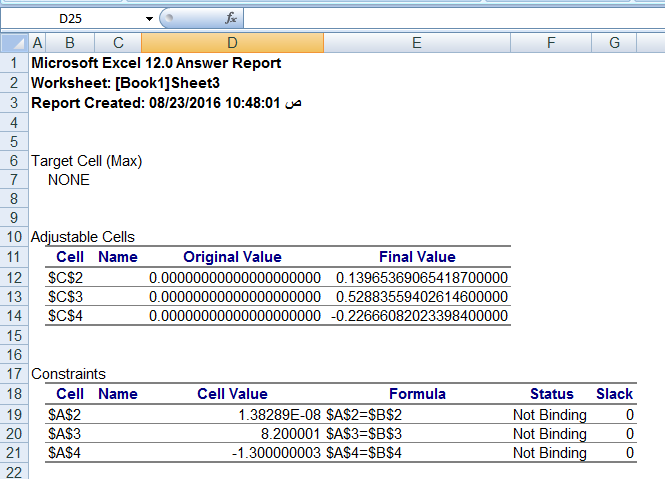 Then the solution shows like in Figure (2).
Then the solution shows like in Figure (2).
Figure (2): Excel Answer
The following Table (3) shows the answers of case by
Excel Solver.
Table (3)
Answers of Excel
|
Variable |
Value |
|
X1 |
0.139653690654187 |
|
X2 |
0.528835594026146 |
|
X3 |
-0.226660820233984 |
Table (4) shows the verifying of the solutions.
Table (4)
verification of Excel
|
Equation |
Constant |
Substitution Value |
The error |
|
Equation 1 |
0 |
1.38 x 10-08 |
-0.0000000138289 |
|
Equation 2 |
8.2 |
8.200001 |
-0.0000001 |
|
Equation 3 |
-1.3 |
-1.3 |
0 |
5. Solution of Case by using Lindo:
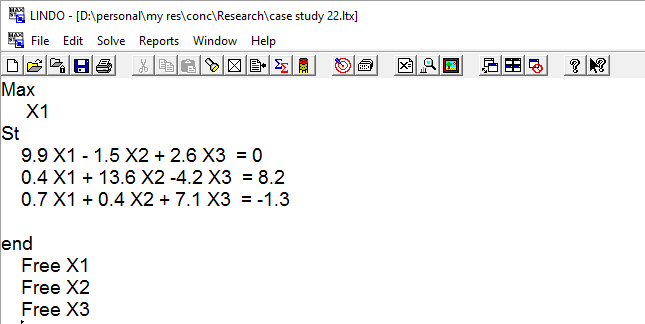 Figure (3) shows the entry of the Case :
Figure (3) shows the entry of the Case :
Figure (3): Lindo input
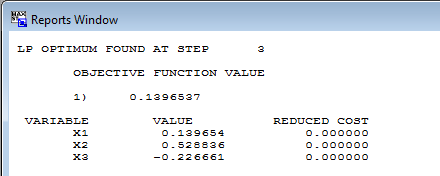 Then the solution appear as shows in Figure (4).
Then the solution appear as shows in Figure (4).
Figure(4): Lindo Answer
The following Table (5) shows the answers of case by Lindo
Table (5)
Answers of Lindo
|
Variable |
Value |
|
X1 |
0.139654 |
|
X2 |
0.528836 |
|
X3 |
-0.226661 |
Table (6) shows the verifying of the solutions of Case using Lindo.
Table (6)
Case verification of Lindo solution
|
Equation |
Constant |
Substitution Value |
The error |
|
Equation 1 |
0 |
0.000002 |
-0.000002 |
|
Equation 2 |
8.2 |
8.2000074 |
-0.0000074 |
|
Equation 3 |
-1.3 |
-1.3000009 |
0.00000089999999989 |
6. Solution of Case Study using Maxima:
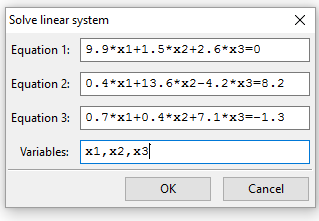 Enter the system as seen in Figure (5)
Enter the system as seen in Figure (5)
Figure (5): Maxima input
Figure (6): Maxima Answers
 Then the solution appears as Figure (6)
Then the solution appears as Figure (6)
The following Table (7) shows the answers of case study 2 using
Maxima.
Table (7)
Answers of Maxima
|
Variable |
Value |
|
X1 |
0.13965367693931500000 |
|
X2 |
0.52883552267193300000 |
|
X3 |
-0.22666081449666100000 |
Table (8) shows the verifying of the solutions of Case using maxima.
Table (8)
verification of Maxima solution
|
Equation |
Constant |
Substitution Value |
The error |
|
Equation 1 |
0 |
0 |
0 |
|
Equation 2 |
8.2 |
8.19999999999999 |
0.000000000000001 |
|
Equation 3 |
-1.3 |
-1.3 |
0 |
6. Solution of Case Study by using SimSolve :
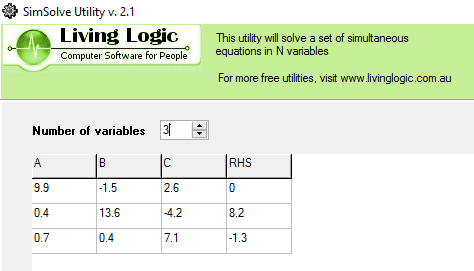 Figure (7) shows the input of the system in SimSolve
Figure (7) shows the input of the system in SimSolve
Figure (7): SimSolve input
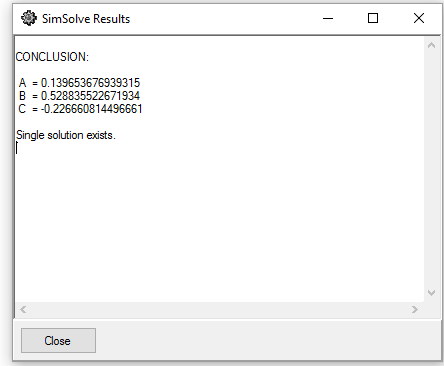 Then the solution shows as Figure (8)
Then the solution shows as Figure (8)
Figure (8): SimSolve Answers
The following Table (9) shows the answers by using SimSolve.
Table (9)
Answers of SimSolve
|
Variable |
Value |
|
X1 |
0.139653676939315 |
|
X2 |
0.528835522671934 |
|
X3 |
-0.226660814496661 |
Table (10) shows the verifying of the solutions of Case 2 using SimSolve.
Table (10)
verification of SimSolve solution
|
Equation |
Constant |
Substitution Value |
The error |
|
Equation 1 |
0 |
0 |
0 |
|
Equation 2 |
8.2 |
8.2 |
0 |
|
Equation 3 |
-1.3 |
-1.3 |
0 |
7. Conclusion : The case study involved a written system contained
a non-integer coefficient to note the differences in accuracy of solutions.
In this case identical solutions of all systems up to 10-6
In the case sudy represents a sample of:
non-integer coefficients, and thus may produce solutions not identical values. This case recorded the following :
|
Error |
||||||
|
Iterative Method |
Excel Solver |
LINDO 6.1 |
MATLAB |
Maxima |
SimSolve |
|
|
Equation1 |
-0.000409 |
0.00000001 |
-0.000002 |
-0.000409 |
0 |
0 |
|
Equation2 |
0.0002999 |
-0.0000001 |
-0.000007 |
0.0002999 |
0 |
0 |
|
Equation3 |
0.0002599 |
0 |
0.00000089 |
0.0002599 |
0 |
0 |
|
Avg |
0.000322 |
0 |
0.000003 |
0.000322 |
0 |
0 |
Avg = (∑ Error )/number of Errors
- All the software in the match results untill 10-5 , exept MATLAB match untill 10-3 .
- MATLAB sofware and Sidel Method (manully) gives same solution .
- Since SimSolve uses one of the methods of elimation (Gauss-Jordan) so there are no errors in the solution to the lack of non-zero values in the coefficients matrix.
By offering a solution in the Maxima it appeared to be running one of the iterative methods, which repeats and substitute until error is belong to zero. So nonexisting error.
References
1.A. Barry (2003). Computational methods in O.R using Lindo and Lingo (2003). Available at: http://www.abarry.ws/books/CalculationMethodsBook.pdf/
2.Bosch, W. W., and Strickland, J. (1998). Systems of linear equations on a spreadsheet. Mathematics & Computer Education, 32, (1), 11-16.
3.Camporesi, Roberto (2016). A Fresh Look at Linear Ordinary Differential Equations with Constant Coefficients. Revisiting the Impulsive Response Method Using Factorization. International Journal of Mathematical Education in Science and Technology, v47 n1 p82-99 2016.
4.Carley, Holly (2014). On Solving Systems of Equations by Successive Reduction Using 2×2 Matrices. Australian Senior Mathematics Journal, v28 n1 p43-56 2014.
5.Deane Arganbright (n. d). Innovative Uses of Excel in Linear Algebra. Department of Mathematics and Computing Science Divine Word University, Papua New Guinea. Available online at: http://atcm. mathandtech. org/EP2011 /regular _papers / 3272011_19192.pdf
6.Edwards, Thomas G.; Chelst, Kenneth R.; Principato, Angela M. and Wilhelm, Thad L. (2015). Investigating Integer Restrictions in Linear Programming. Mathematics Teacher, v109 n2 p136-142 Sep 2015.
7.El-Gebeily, M. and Yushau, B. (2008). Linear System of Equations, Matrix Inversion, and Linear Programming Using MS Excel. International Journal of Mathematical Education in Science and Technology, 39(1), 83-94.
8.Greg Harvey (2007). Microsoft Office Excel 2007: All-in-one desk reference .Wiley Publishing, Inc.
9.Jerome, Lawrence (2012). Generalized assignment matrix methodology in linear programming. International Journal for Technology in Mathematics Education, v19 n1 p25-41 2012.
10.LINDO User’s Manual (2003). LINDO SYSTEMS INC. Available online at: http://www.lindo.com.
11.Macsyma system (2001). Maxima User Manual.
12.Martin Golubitsky and Michal Dellnitz (1999). Linear algebra & differential equations using MATLAB. An International Thomson Publisher Company.
13.Mike Brookers (2011). The Matrix Reference Manual. Imperial College – London.
14.N. I. Danilina, N. S. Dubrovskaya, O. P. Kvasha and G. L. Samirov (1988). Computational Mathematics. Mir Publisher.
15.O. V. Manturov and N. M. Matveev (1989). A Course of Higher Mathematics. Mir Publisher.
16.R. L. Burden and J. D. Faires (2011). Numerical Analysis (9th ed.).Youngstown State University.
17.Roanes-Lozano, Eugenio (2011). Some applications of algebraic system solving. International Journal for Technology in Mathematics Education; 2011, Vol. 18 Issue 3, p149.
18.Stephen Moffat (2011). Excel 2010 Part II. Stephen Moffat & bookboon.com Available online at: http //www.bookboon.com.
